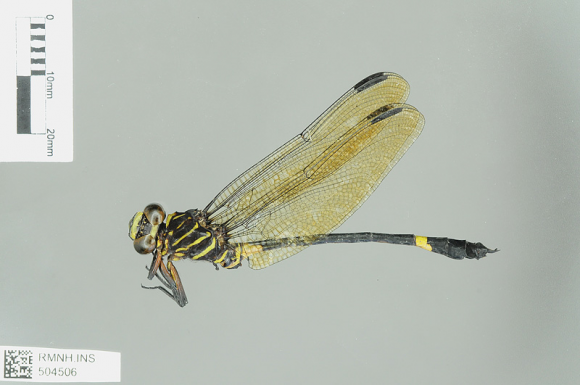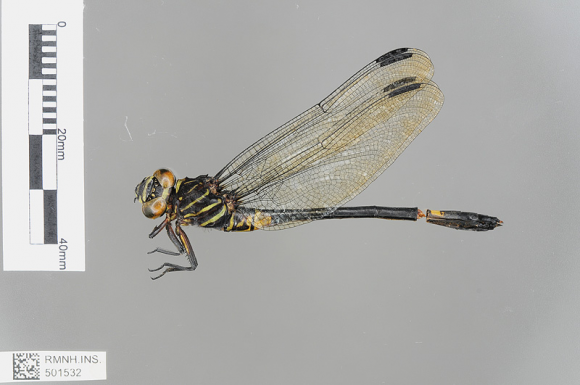Diastatomma gamblesi Legrand, 1992
Western Hoetail
Type locality: Mt Nimba, Guinea
Diagnosis
The only Diastatomma species currently known in the Upper Guinea (Sierra Leone to Ghana), male recalling D. multilineatum by (a) black on fronto-clypeal suture wide on both sides of suture and broadly fused with black on lower postclypeus; (b) two dorsal black stripes usually interrupt apical pale ring on S2, but basal pale ring on S3 complete; (c) inner branch of cercus almost perpendicular to cercus axis, angle between them about 80º; branch more parallel-sided and square-cut at end. However, (1) Hagen’s tubercle on underside S1 is stalked, its clubbed end bearing knob and two slender processes, like an arm with clenched fist and unfurled thumb and little finger; (2) posterior hamule is shallowly incised, its anterior border rounded.
Habitat description
Mostly streams, but also headwaters, shaded by forest. Often with coarse detritus and a gravelly and/or sandy bottom. Inferred to occur from 0 to 800 m above sea level, but mostly below 600.
Distribution
 Appendages (dorsal view) |
 Posterior hamule (lateral view) |
 Tubercle (frontal view) |
 Tubercle (lateral view) |
Map citation: Clausnitzer, V., K.-D.B. Dijkstra, R. Koch, J.-P. Boudot, W.R.T. Darwall, J. Kipping, B. Samraoui, M.J. Samways, J.P. Simaika & F. Suhling, 2012. Focus on African Freshwaters: hotspots of dragonfly diversity and conservation concern. Frontiers in Ecology and the Environment 10: 129-134.
Barcode specimen(s):

Male; Liberia, Nimba County, West Nimba Proposed Forest Reserve © Dijkstra, K.-D.B. & M. Darpay

Male; Sierra Leone, Eastern Province, Gola Forest © Dijkstra, K.-D.B. & A. Dayeker

Female; Liberia, Grand Gedeh County, Putu Iron Ore Mining concession © Dijkstra, K.-D.B. & A. Dayeker

Female; Liberia, Nimba County, Mt Tokadeh © Dijkstra, K.-D.B.
Reference
- Legrand, J. (1992). Revue francaise Entomologie Nouvelle Serie 14, 4, 187-190. [PDF file]
Citation: Dijkstra, K.-D.B (editor). African Dragonflies and Damselflies Online. http://addo.adu.org.za/ [2024-10-31].

